About Author:
Buddhi Bal Chidi
Department of Pharmacy,
Maharajgunj Medical Campus, Institute of Medicine,
Tribhuvan University, Kathmandu, Nepal
buddhibal_chidi@iom.edu.np
Abstract:
Demand of herbal medicine had increased incredibly now a days. Medicine from part of herbal product is found highly efficacious and potent for curing diseases. These products are considered significantly for particular purpose as they show good pharmacological activities. This article gives an idea of basis of Cordyceps sinensis. It is a well known valued traditional medicine which perform nourishing tonic. To date, it is believe that it possesses potential pharmacological action on human body like Anti-inflammatory, Antioxidant, Hyperglycaemia, Sexual dysfunction, Immunomodulating effects, Asthemia, Heart ailment, Hepatoprotective, Immunoresponse, Hyperlipidemia / Hypercholesterolemia, Anti-cancer, Anti-bacterial, Anti-fungal, Anti-hypertensive, Anti-spasmodic, Adaptogenic, Adreno-tonic. This article contains more generalization about O. sinesis which would be better informative.
Reference Id: PHARMATUTOR-ART-1972
Introduction:
Plant Profile:
Cordyceps sinensis(Berk.) Sacc., belonging to the family Clavicepitaceae, is a naturally growing bio-material popular as a herbal medicine in Nepal. It is popularly known as "Yarsa gumba" and also as "Jeeban Buti" in Nepal. Because of its significant health benefits and its rarity, Yarsa gumba, is a very expensive herb. Yarsa gumba is one of the highly potentially medicinal herbs commonly found throughout alpine grassland of the Himalayas of Nepal, including those of China, Bhutan and India. During the summer and early autumn, mature fruiting bodies of Yarsa gumba release millions of ascospores in the air, which infect the larvae through its soft skin and germinate inside the larva body. The harvesting period of Cordyceps sinensis is between the months of May and July. [1, 2]
It is commonly known as Yarsa gumba or
Nepali Name: Yarsa gumba, Jibanbuti
English Name: Caterpillar fungus/ Mushroom or Cordyceps
Chinese Name: Dong Chong Xia Cao
Korean Name: Tong ch'ug ha ch'o
Bhutanese Name: Bub
Japanese Name: Tochu-Kaso
Tibetan Name: ‘summer-grass winter-worm’
Cordyceps sinensisis from ergot family having natural habit of parasitic, non chlorophyllous, annual fungus. It has two components, the lower part is dead caterpillar and the upper part is a fungus. The fungus has a small spike with dark brown fructification and yellowish white stalk. The size of the fungus is about 4 to 12 cm in length and 0.14 to 0.4 cm in girth. [3, 4]
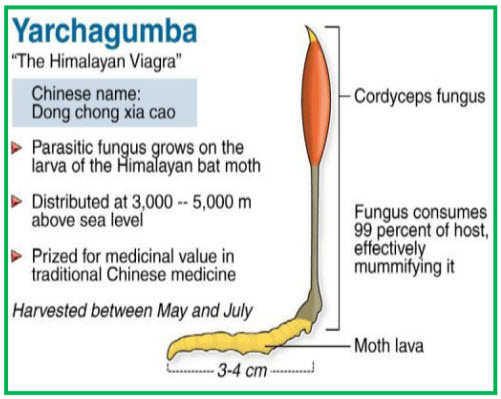
Fig: 1 Yarsa gumba, Most Expensive Insect- Herb
Taxonomical Classification:[5]
Kingdom: Fungi
Division: Ascomycota
Class: Sordariomycetes
Order: Hypocereles
Family: Clavicipitaceae or Ophiocordycipitaceae
Genus: Cordyceps
Species: sinensis
The fungus was known as Cordyceps sinensis up to 2007 and after that emphasized molecular analysis used to emend the classification the Cordycipitaceae and the Clavicipiataceae, thus resulting in the naming of new family Ophiocordycepitaceae and transfer of several Cordyceps sinensis to the Ophiocordyceps. [48]
Distribution:
The herb is naturally distributed in alpine pastures of Nepal, India, China and Bhutan ranging from 300 to 500 m altitude from sea level. [6] Cordyceps sinensis grows in the larvae of night flying moth of mountain region which can found in different parts of Nepal at above 3800 m altitude. There are more than 310 species of Cordyceps sinensis but Webster 1980 and Sarbhoy 1983 had reported that 150 species of Cordyceps are known. Out of these species have medicinal value and among them, Cordyceps sinensis is one of the highly valuable species of the world. [7] In Nepal, there are three types of Cordyceps species found, they are
- Cordyceps sinensis
- Cordyceps militaris
- Cordyceps nutans
Botanical Description:
The name Cordyceps comes from the Latin words: cord and ceps, meaning "club" and "head", respectively. The Latin conjugation accurately describes the appearance of the club fungus, Cordyceps sinensis, whose stroma or fruit body extend from the mummified carcasses of insect larvae, usually caterpillar larva of the Himalayan Bat Moth, Hepialis armoricanus shown in Fig.2
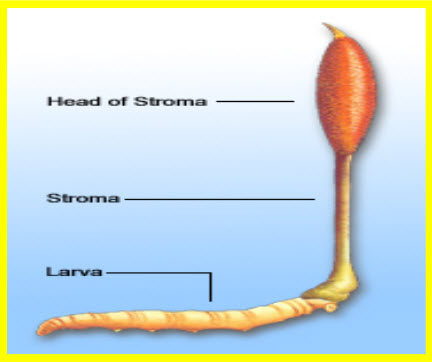
Fig: 2. Hepialis armoricanus
The fruit body of the Cordyceps sinensis mushroom originates at its base on an insect larval host (usually the larva of the Himalayan bat moth, Hepialis armoricanus) and ends at the club-like cap, including the stipe and stroma. The fruit body is dark brown to black; and the ‘root’ of the organism, the larval body pervaded by the mushroom's mycelium, appears yellowish to brown in color. The immature larva, which forms the host upon which the cordyceps grows, usually lives about 6 inches below ground. The infesting spores of the Cordyceps, which are thought by some mycologists to be the infectious agent for the insect, are ca. 5-10 um long. As the fungus approaches maturity, it will have consumed greater than 99 % of the infested organism, effectively mummifying the host. As the stroma matures, it will swell and develop perihelia. The mycelium is formed and the body of the larva becomes sclerotuid to withstand the winter. As the sclerotuim develops, the inner organs of the larva are destroyed, leaving the exo-skeleton intact. Optimal conditions permitting; the spores are eventually discharged and taken by the wind or fall within a few centimeters of their origin. [9, 10, 11]
Traditional Uses:
Cordyceps sinensis is one of the most valuable medicinal herbs in Traditional Chinese Medicine (TCM). This herb has an extensive history of use in the treatment of mental and physical exhaustion and is often used as a rejuvenative for increased energy while recovery from serious illness. [12] It is used as an aphrodisiac and as a treatment for variety of ailments from fatigue to cancer. It improves appetite, stamina, libido, endurance, and sleeping patterns. Its main application is: for treating exhaustion, respiratory and pulmonary diseases, back pain, and sexual problems (eg premature ejaculation, lack of sex drive). In TCM, it is regarded as having an excellent balance of Yin and Yang as it is apparently both animal and vegetable. [13] In the Dolakha District (Central-east Nepal), the Sherpa people use cordyceps as an aphrodisiac and tonic: “One to two fruiting bodies are orally administered with milk, once a day.”According to Sacherer, in the Rolwaling Valley of the same District, the product is popularly used as a tonic and aphrodisiac and “it is eaten in its entirety, caterpillar and fungus, mostly by middle aged men. In Nar (Central Nepal, Manang District), it is said that “if a person mixes yarsa gumba with 13 other herbs and takes the mixture over a period of three years, he will become as thick as an elephant, quick as a horse and pretty as a peacock,”and it has been assessed that “the product is ground, boiled in milk and drunk with honey or rock candy.” According to a publication by the Ministry of Forests and Soil Conservation of Nepal, in the Thak areas (Central Nepal) cordyceps “is taken orally in combination with Dactylorhiza hatagirea (Orchidaceae), honey and cow’s milk,” and it is also administered as a tonic to yak and sheep. [14, 15, 16, 17] An attempt was made to evaluate the strength of the folk claims by counting the number of users for particular illnesses. Prolonged, continuous use by local folk healers/traditional healers for the treatment of 21 ailments, including cancer, bronchial asthma, bronchitis, TB, diabetes, cough and cold, erectile dysfunction, BHP, jaundice, alcoholic hepatitis, etc., were noted . Most traditional healers and elderly people use it to increase longevity and cure erectile dysfunction. [18]. Local folk practitioners use the product alone or in combination with other medicinal herbs to treat various diseases, administering different doses for different ailments according to their experience, based on an empirical trial-and-error method. People of both sexes usually take one piece of C. Sinensis with a cup of milk to enhance their sexual potency and desire. The Bhutia communities put one piece of C. Sinensis in a cup of local-made alcohol (chang), leave it for 1 hour, and drink it morning and evening as a tonic. Some use hot water instead of alcohol. Some folk healers use C. Sinensis for diabetes and other wasting diseases. It is used for cancer mixed with texus leaf and Ginseng root decoction. Similar reports are also available from Nepal. [19, 20, 21]
Life Cycle:
Natural regeneration takes place from the spores of the fungus. At the beginning of the monsoon period, the spores attack the caterpillar just after it has emerged from its cocoon. If the fungus is collected in early monsoon then the caterpillar is still seen alive, later monsoon, at the time of collection, the caterpillar will not be alive. The fungal part of this species can be seen growing out of the ground immediately after the snow melts the caterpillar part remains buried under the soil. Although, Yarsa gumba is being cultivated in America by growing the strain of soyabeans for medicinal uses, such species is not cultivated in Nepal.[3] Ascopores which are released from stroma of C. sinensis are sexual spores. But, when ascopores fall down in ground or infect host, then they produce conidia which are asexual spores, both ascopores and canidia can infect their hosts. It is an entomogenous fungus, the spores of which in millions are widely dispersed by wind and water in autumn. Some of the spores fall, germinate and penetrate into the caterpillar larva of Hepialis species of the Lepidoptera order of insects (moths). The infected caterpillar are killed by spring, when the fungal fruiting body produces from the caterpillar larvae head and whole internal body of the insect has become hardened medicinal mycelium. The uninfected caterpillars pupate into relatively large primitive moths and take two years to complete life cycle. The caterpillar lives in vertical tunnels in the soil and emerges at night to feed on roots and aerial parts of plants. [22]
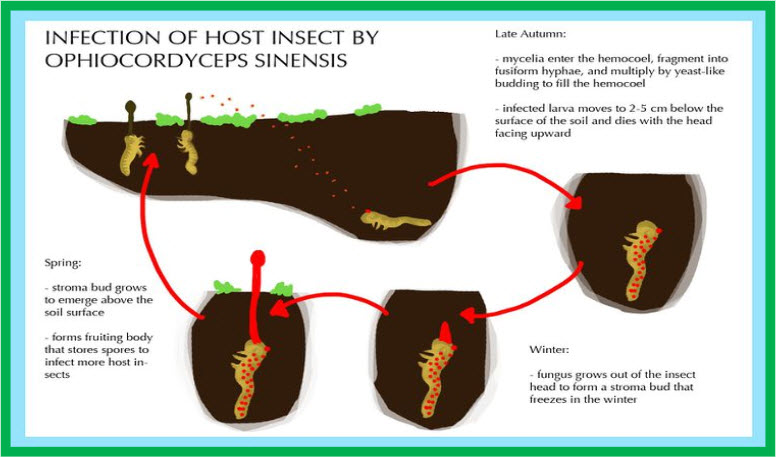
Fig: 3. Life Cycle of Ophiocordyceps sinensis from autumnal infection and winter-stromal bud stage to summer-fruiting body stage
Chemical Constituents:
Phytochemical analysis of O. sinensis had led to isolation of proteins and nitrogenous compounds, polysachharides, sterols, nucleosides, fatty acids and their derivatives, vitamins and inorganic. [23, 24] Nucleosides are regarded as the active components and adenosine has been used as a marker for quality control of Cordyceps sinensis. Eleven nucleoside compounds have been found in natural cordyceps. The major nucleosides in Cordyceps sinensis include adenine, uracil, uridine, guanosine, thymidine and deoxyuridine. [25, 26] The chemical components such as ergosterol, adenosine, cordycepin, guanosine, inosine, uridine, mannitol and polysaccharides are major components of wild Cordyceps sinensis. Sterols, including ergosterol, Δ-3 ergosterol, ergosterol peroxide, 3-sitosterol, daucosterol, and camposterol. [26]
Polysaccharides and sugar derivatives were identified and their pharmacological activity has been reported. A group of oligosaccharides and polysaccharides isolated from natural cordyceps stimulate macrophage function, and promote lymphocyte transformation. A bioactive 23-kd-protein-bound polysaccharide was shown to consist mainly of mannose and galactose in a ratio of 3 to 5, and protein. [14] In addition to all the essential and non-essential amino acids such as phenylalanine, proline, histidine, valine, oxyvaline, arginine, glutamic acid. Cordyceps contains uncommon cyclic dipeptides including cyclo-(Gly-Pro), cyclo- (Leu-Pro), cyclo-(Val-Pro), cyclo-(Ala-Leu), cyclo-(Ala-Val), and cyclo-(Thr-Leu). Small amounts of polyamines, including 1, 3-diamino propane, cadaverine, spermidine, spermine, and putrescine, have been identified. [23] Cordycepic acid, cordycepin, fatty acids and other organic acids. Twenty-eight saturated and unsaturated fatty acids and their derivatives have been isolated from Cordyceps sinensis. Polar compounds of natural cordyceps extracts include many compounds of hydrocarbons, alcohol, and aldehyde. [26, 27] Inorganics compounds including K, Na, Ca, Mg, Fe, Cu, Mn, Zn, Pi, Al, Si, Ni, Sr, Ti, Cr, Ga, V, and Zr. It has been reported that the presence of the significant amount of vitamins, including vitamins B1, B2, B12, E, and K.[24] Several characteristic compounds have been reported from C. sinensis.
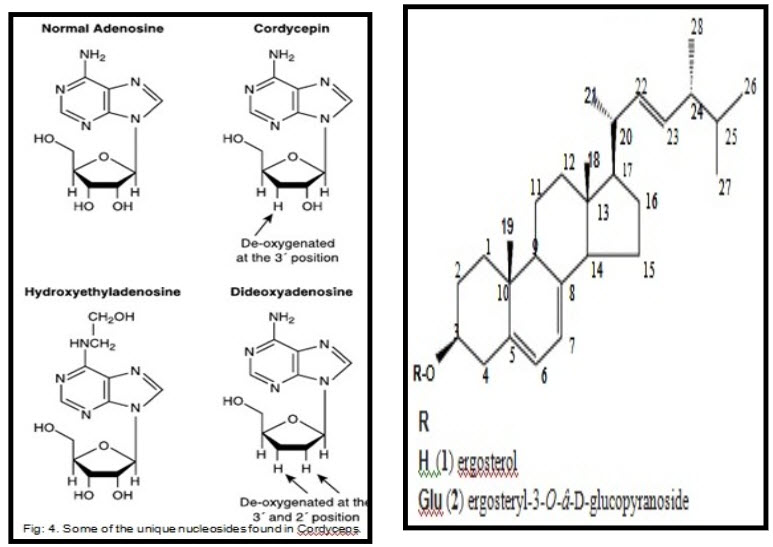
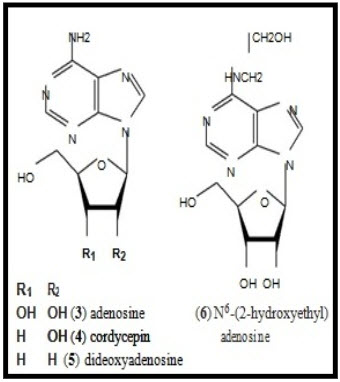
Toxicological Profile:
There are very few reports of toxic side effects like dry mouth, nausea or diarrhea. Cordyceps is considered to be safe; an oral median lethal dose could not be defined. Doses in mice of 80 g/kg body weight did not cause death. [28] No toxic effects on cell proliferation were demonstrated in mice. [29] Safety of cordyceps consumption in reaction to the immune system was evaluated in mice, with an up regulation of the immune response demonstrated in the absence of splenomegaly. [30] Experiments in mice suggest cordyceps has an effect on plasma testosterone levels. [31, 32] Rabbit given 10 g/kg per day (n=6) did not show any abnormalities in blood test or in kidney or liver function. [33]
Reported Pharmacological Profile:
In traditional medicine practices, the therapeutic effects are due to contribution of multiple components, not only the major ones. In vitro evaluation and animal studies of cordyceps and its chemical constituents suggest potential therapeutic applications. The range of therapeutic uses claimed for cordyceps species is far reaching and most of them have yet to be sufficiently investigated. In TCM, cordyceps have been used to treat conditions including respiration and pulmonary diseases, renal, liver and cardiovascular diseases, hyposexuality and hyperlipidemia. It is also used in the treatment of Immune disorder and as an adjunct to modern cancer therapies.
Cytotoxicity:
There are numerous reportsin vitro and animal experiments have been conducted on aqueous and ethanol extracts of cordyceps, as well as with cordycepin and oxypiperazines extracted from the mycelium. The extracts enhanced cytokine activity and induced cell cycle arrest and apoptosis, thereby reducing tumor cell proliferation and enhancing survival times. Limited clinical studies report subjective improvement of symptoms, increased tolerance of radiation and chemotherapy (possibly caused by enhanced immune function), and reduction in tumor size with co administration of cordyceps. Animal experiments suggest a protective role for cordyceps in radiation and chemotherapy induced injury, with increased survival times demonstrated in mice. [34, 35, 36, 37]
Anti-inflammatory:
There are several reports of anti inflammatory property from extract of O. sinensis. In vitro effects include enhanced phagocytosis activity of macrophages, increased enzymatic activity of acid phosphates, and induction of interleukin and tumor necrosis factor producing a decrease in cyclooxygenase-2 expression has also been demonstrated in vitro. [38]
Cardiovascular action:
Cordycepshas a long history of traditional medicinal use in heart disease. Adenosine and other nucleosides are thought to be responsible for the effects seen in animal studies. A vasodilator action has been reported in anesthetized dogs, and hypotensive and vaso-relaxant effects have been demonstrated in rats. Reduced heart rate and restoration from arrhythmias have also been shown in animals. Long-term, open-label clinical studies in cardiac failure have described cordyceps effect in improving cardiac function, arrhythmias, and overall quality of life, but are yet to be substantiated by large, high-quality clinical trials. Fibrinolytic action of a cordyceps extract has been shown in vitro on bovine and human serum. Platelet aggregation has been inhibited in rabbits and in human platelets in vitro. A positive effect on hyperlipidemia has also been reported in aqueoushot-water extract of O. sinensis can change very-low-density lipoprotein pluslow-density lipoprotein (VLDL+LDL) and consequently decreased the atherogenic index and decreased blood serum cholesterol levels.[24, 34, 40] Use of C sinensis to reduce acute and chronic rejection associated with cardiac transplantation. The use of C. sinensis extract in conjunction with a sub-therapeutic dose of cyclosporine significantly reduces CD8+ T cell activity and can suppress acute rejection, ablates allograft vasculopathy.[27, 39]
Hepatoprotective action:
There are several reports of the protective effect of C. sinensis extract for liver cirrhosis. Extract of C. sinensis reported polysaccharides from C. sinensis can decrease superoxide dismutase (SOD) activity and ameliorate local necrosis in liver.[41, 42] Open-label clinical studies conducted in patients with active hepatitis and post hepatic cirrhosis reported improvements in liver function tests.[34]
Respiratory action:
C. sinensis is known for its beneficial effect on variouslung ailments as well as in severe acute respiratory syndrome. In vitro studies suggest aqueous extracts of C. sinensis have a stimulatory effect on ion transport in human airway epithelial cells, possibly because of cordycepin andadenosine stimulated ion transport in dose-dependent manner in Calu-3 monolayers and which may be responsible for anion movement from the basolateral to apical compartments in the airway epithelia. Basolateral Na+-K+-2Cl- co transporter and apical cAMP-dependent cystic fibrosis transmembrane conductance regulator Cl- channel are involved in the process leading to pharmacological effect on the respiratory tract. Animal studies suggest the observed effects on respiration are caused by enhanced oxygen utilization capacity, supporting the traditional use of cordyceps in Tibet and Nepal to offset altitude sickness. Clinical studies conducted in asthma, chronic obstructive pulmonary disease, and bronchitis have suggested efficacy for cordyceps.[34, 43]
Antioxidant activity:
Traditionally, cordyceps has been used in the elderly population to improve weakness, impotence, and fatigue associated with aging. Increase in learning and memory have been shown in experiments in aged mice. Improvements in self-reported symptoms have been described, as have increased in red blood cell superoxide dismutase activity and decreases in malondialdehyde levels. It reported cordymin in C. sinensis which significantly enhanced the defense mechanism against cerebral ischemia by increasing antioxidants activity related to lesion pathogenesis leading the brain recover from ischemic injury. Other antioxidant effects, hydroxyl radical scavenging activity, and decreases in lipid peroxidation are thought to be responsible for the antiaging effects. [34, 42, 44, 45]
Antidiabetic action:
Animal studies suggest cordyceps, particularly the polysaccharide extracts decreases blood glucose levels by improving glucose metabolism and enhancing insulin sensitivity. Few clinical trials exist; however, a small (N = 20), randomized trial found that taking C. sinensis 3g daily improved the blood sugar profile over placebo.[28, 34, 44] . An antioxidant CSp-1 (106) was reported which showed strong hypoglycemic properties increased circulating insulin level in diabetic animals, by stimulating pancreatic release of insulin and/or reduce insulin metabolism. [46]
Immunomodulating and renal action:
Safety of cordyceps consumption with relation to the immune system was evaluated in mice, with an up regulation of the immune response demonstrated in the absence of splenomegaly and enhanced splenocyte proliferation, increased plasma corticosterone, decreased production of immunoglobulin E, and modulation of cytokine and CD4+ and CD8+ cell production were reported. [30, 39] An Immunomodulating effect of C. sinensis in kidney transplanted patients is reported.[47] Clinical studies among elderly patients with long-term renal failure suggest improved renal function as demonstrated by increases in creatinine clearance, and decreases in blood urea nitrogen and serum creatinine. In transplantation recipients, the incidence of nephrotoxicity was lower among cordyceps-treated patients, thus allowing for higher cyclosporin A dosing. [34, 38]
Sexual dysfunction:
C. sinensis, a trusted aphrodisiac, which enhances libido and fertility in both sexes. Steroidogenic enzyme expression in human granulosa-lutein cells is reported. Experiments in castrated rats showed a mild effect on sexual function. Decreases in erection and mount latency were demonstrated, but no effect on ejaculation latency was found. However, actions on steroidogenesis and testosterone have been shown. Clinical studies in elderly populations showed improved sexual drive and virility were reported. [24, 31, 32, 34]
Conclusion:
Various researches revealed that the use of cordyceps began from history for curing various disorders. The constituents present in the cordyceps have beneficial action on human physiologies which were reported. The therapeutic application of cordyceps is due touniqueness of potency and efficacy in contemporary medicine world. In Nepal, cordyceps sinensis is found abundantly throughout the north-west to east part of Himalayan region but no profound research have been conducted up on it till now for their molecular analysis. It is known as Himalayan honey by a Nepali ethnic group and aware too much about it that cordyceps is useful in curing various diseases. Every year, it has been collected in Nepal during winter season and transport to the India, China and many other countries. Though the collection process is very intricate, it is ongoing from over year not only for the personal interest but also to strengthen their economic status. Cordyceps sinensis is regarded as expansive life saving tonic medicinal herb. That’s why its popularity is increasing greatly all over the world.
References:
[1] Shrestha B. Diversity of Cordyceps Fungi in Nepal. Nepal Journal of Science and Technology. 2011; 12: 103-10
[2] Shrestha B. Yarsa gumba (Ophiocordyceps sinensis): A national pride of Nepal. SONIK Souvenir 2010. PDF from sonik.org.np.
[3] Parajuli DP, Gyanwali AR, Shrestha BM. Manual of Important Non- Timber Forest Products in Nepal 1998. Institute of Forestry/International Tropical Timber Organization. Pokhara, Nepal. Family: Hypocreaceae.
[4] IUCN Nepal. National Register of Medicinal Plants. Kathmandu: IUCN Nepal. 2000 Ix + 163 pp.
[5] Sung GH, Hywel-Jones NL, Sung JM, Spatafora JW. International Mycological Association. 2007. Retrieved 2011-07-19
[6] Balfour-Browne FL. Some Himalayan fungi. Bull. Brit. Mus. (Nat. Hist.) 1, 1955; 189−218
[7] Mallet J, Woiwod IP, Reynolds DR, Thomas CD (Eds.). Insect Movement: Mechanisms and Consequences. CAB International, Wallingford, UK. 2001; 337-360
[8] Shah K. YONSAKTI BARDHAK PRACRITIC AUSHADI: YARSAGUMBA KO KATHA (Nepali); Sadhan news paper 1996; vol: 37, Kathamandu, Nepal
[9] Chatterjee R, Srinivasan KS, Maiti PC. Cordyceps sinensis: Structure of cordycepic acid. J. Am. Pharm. Assoc. 1957; 46:114-118.
[10] Shrestha R, Bhandary H. Study on Exploitation of Cordyceps sinensis 1997. Research Center for Applied Science and Technology, Tribhuvan University, Kirtipur, Kathmandu, Nepal.
[11] Medicinal Plants of Nepal. H.M.G. of Nepal Ministry of Forests and Soil Conservation, Department of Medicinal Plants, Thapathali, Kathmandu, Nepal, 1993; 116.
[12] Xie Z, Huang X, Lou Z, Li S, Zhou L, Yuan S, Yang Z, Tang Z. Dictionary of Traditional Chinese Medicine 1988. The Commercial Press Ltd, Hong Kong
[13] Bensky D, Gamble A, Clavey S. Materia Medica: Chinese Herbal Medicine (3rd Ed.). Seattle, Washington: Eastland Press 2004.
[14] Wang SY, Shiao MS. Pharmacological function of Chinese medicinal fungus Cordyceps sinensis and related species. J Food Drug Anal. 2000; 8: 248–57.
[15] Li SP, Li P, Dong TT, Tsim KW. Anti –oxidant activity of different types of natural Cordyceps sinensis and cultured Cordyceps mycelia. Phytomedicine. 2001;8:207–12
[16] Tsuno A, Taketomo N, Hiroyuki I. Healthful composition obtained from the hot water extracts of Cordyceps sinensis mycelia. J Lab Clin Med. 1995; 8:134–7.
[17] Xiao YQ, Liu JM, Tu YY. Studies on chemical constituents in Cordyceps sinensis. Bull Chin Mater Med. 1983; 8:32–3.
[18] Panda AK. Tracing the historical prospective of Cordyceps sinensis –an aphrodisiac in Sikkim Himalya. Ind J Hist Sci. 2010; 45: 189–98.
[19] Devokota S. Yarsa gumba [Cordyceps sinensis (Berk.) Sacc.]. Traditional utilization in Dolpa district. West Nepal. Our Nat. 2006; 4:48–52.
[20] Lama YC, Ghimire SK, Thomas YA. Amchis’ Knowledge and Conservation. Kathmandu: People and Plants Initiative, WWF Nepal Program, Medicinal Plants of Dolpo. 2001; p. 56.
[21] Adhikari MK, Devkota S, and Tiwari RD. Ethnomycolgical Knowledge on Uses of Wild Mushrooms in Western and Central Nepal. Our Na. 2005; 3: 13–9.
[22] Namgyel P. Household Income, Property Rights and Sustainable Use of NTFP in Subsistence Mountain Economy 2003: The Case of Cordyceps and Matsutake in Bhutan Himalayas.
[23] Holliday J, Cleaver M. On the Trail of the Yak, Ancient Cordyceps in the Modern World. 2004:
[24] Zhu JS, Halpern GM, Jones K. The Scientific Rediscovery of an Ancient Chinese Herbal Medicine: Cordyceps sinensis. Part I. Journal of Alternative and Complementary Medicine. 1998; 4(3): 289-303.
[25] Liu Y, Xu F, Chen B, Zhang J, Yao S. CZE determination of nucleosides and nucleobases from natural Cordyceps sinensis and cultured Cordyceps militaris. Yaowu Fenxi Zazhi. 2010; 30: 24-29.
[26] Yang ML, Kuo PC, Hwang TL, Wu TS. Anti-inflammatory principles from Cordyceps sinensis. Journal of Natural Products. 2011; 74: 1996-2000.
[27] Yu S, Zhang Z, Fan M.. Analysis of volatile compounds of mycelia of Hirsutella sinenis, the anamorph of Ophiocordyceps sinensis. Applied Mechanics and Material. 2012; 140: 253-257.
[28] Li SP, Yang FQ, Tsim KWK. Quality control of Cordyceps sinensis, a valued traditional Chinese medicine. Journal of Pharmaceutical and Biomedical Analysis. 2006; 41: 1571-1584
[29] Mizuha Y, Yamamoto H, Sato T. Water extract of Cordyceps sinensis (WECS) inhibits the RANKL-induced osteoclast differentiation. Biofactors. 2007; 30(2):105-116.
[30] Ka Wai Lee S, Kwok Wong C, Kai Kong S, Nam Leung K, Wai Kei Lam C. Immunomodulatory activities of HERBSnSENSES Cordyceps—in vitro and in vivo studies. Immunopharmacol Immunotoxicol. 2006; 28(2): 341-360.
[31] Huang YL, Leu SF, Liu BC, Sheu CC, Huang BM. In vivo stimulatory effect of Cordyceps sinensis mycelium and its fractions on reproductive functions in male mouse. Life Sci. 2004; 75(9):1051-1062.
[32] Wong KL, So EC, Chen CC, Wu RS, Huang BM. Regulation of steroidogenesis by Cordyceps sinensis mycelium extracted fractions with (hCG) treatment in mouse Leydig cells. Arch Androl. 2007; 53(2): 75-77.
[33] Huang Y, J Lu, Zhu B, Wen Q, Jia F, Zheng S, Chen T, Li Y, Cheng G, Yi Z. Toxicity study of fermentation - Cordyceps mycelia B414. Zhongchengyao. 1987; 10:24-25
[34] Holliday JC, Cleaver MP. Medicinal value of the caterpillar fungi species of the genus Cordyceps (Fr.) Link (Ascomycetes). A review. Int J Med Mushr. 2008; 10(3): 219-234.
[35] Chen Y, Guo H, Du Z, Liu XZ, Che Y, Ye X. Ecology-based screen identifies new metabolites from a Cordyceps-colonizing fungus as cancer cell proliferation inhibitors and apoptosis inducers. Cell Prolif. 2009; 42(6):838-847
[36] Lee SJ, Kim SK, Choi WS, Kim WJ, Moon SK. Cordycepin causes p21WAF1-mediated G2/M cell-cycle arrest by regulating c-Jun N-terminal kinase activation in human bladder cancer cells. Arch Biochem Biophys. 2009; 490(2):103-109.
[37] Liu WC, Chuang WL, Tsai ML, Hong JH, McBride WH, Chiang CS. Cordyceps sinensis health supplement enhances recovery from taxol-induced leukopenia. Exp Biol Med (Maywood). 2008; 233(4): 447-455.
[38] Zhu JS, Halpern GM, Jones K. The scientific rediscovery of a precious ancient Chinese herbal regimen: Cordyceps sinensis: part II. J Altern Complement Med. 1998; 4(4): 429-457.
[39] Jordan JL, Sullivan AM, Lee TDG. Immune activation by a sterile aqueous extract of Cordyceps sinensis: mechanism of action. Immunopharmacology and Immunotoxicology. 2008; 30:53-70.
[40] Koh JH, Kim JM, Chang UJ, Suh HJ. Hypochlesterolemic effect showed hot-water extract of mycelia of Cordyceps sinensis. Biological & Pharmaceutical Bulletin. 2003; 26: 84-87.
[41] Lu Y, Qiu X, Liu X, Zhu J, Feng X, Zhang Y. Protective effect of polysaccharides from different parts of cultured Cordyceps sinensis on CCl4-induced liver damage in mice. Shipin Kexue. 2011; 32: 319-322.
[42] Wang J, YM. Liu, W Cao, KW Yao, ZQ Liu, JU Guo. Anti-inflammation and antioxidant effect of Cordymin, a peptide purified from the medicinal mushroom Cordyceps sinensis, in middle cerebral artery occlusion-induced focal cerebral ischemia in rats.Metabolic Brain Disease. 2012; 27: 159-165
[43] Yue GGL, CBS Lau, KP Fung, PC Leung, WH Ko. Effects of Cordyceps sinensis, Cordyceps militaris and their isolated compounds on an ion transport in Calu-3 human airway epithelial cells. Journal of Ethnopharmacology. 2008; 117: 92-101.
[44] Ng TB, Wang HX. Pharmacological actions of Cordyceps, a prized folk medicine. J Pharm Pharmacol. 2005; 57(12): 1509-19
[45] Ji DB, Ye J, Li CL, Wang YH, Zhao J, Cai SQ. Antiaging effect of Cordyceps sinensis extract. Phytother Res. 2009; 23(1):116-22
[46] Li SP, Zhang GH, Zeng Q. Hypoglycemic activity of polysaccharide, with antioxidation, isolated from cultured Cordyceps mycelia. Phytomedicine. 2006; 13: 428-433.
[47] Xu F, Huang JB, Jiang L, Xu J, Mi J. Amelioration of cyclosporine nephrotoxicity by Cordyceps sinensis in Kideny transplanted recipients. Nephrology Dialysis Transplantation. 1995; 10: 142-43
[48] Sung GH, Jones NLH, Sung JM, Luangsa JJ, Shrestha B, Spatafora JW. Phylogenetic Classification of Cordyceps and the calvicipatious fungi. Study in Mycology. 2007; 57: 5-59
NOW YOU CAN ALSO PUBLISH YOUR ARTICLE ONLINE.
SUBMIT YOUR ARTICLE/PROJECT AT articles@pharmatutor.org
Subscribe to Pharmatutor Alerts by Email
FIND OUT MORE ARTICLES AT OUR DATABASE











.png)

